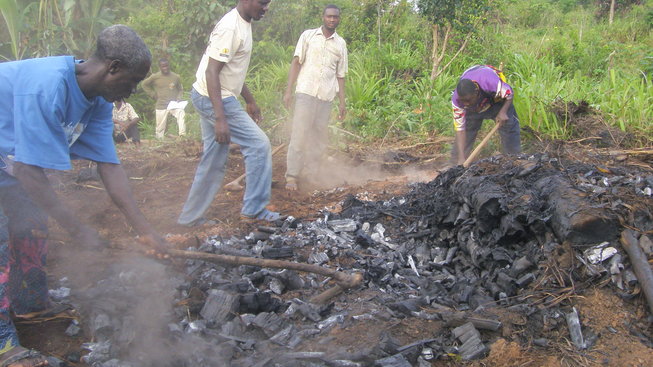Factor four increace in charcoal efficiency
Better kilns double charcoal output and use of improved stoves cut consumption by half. Charcoal is main fuel used for cooking among the urban population in Togo. At the same time Togo is one of the countries with highest deforestation rate.

 Naturvernforbundet has for several years highlighted the importance of energy efficiency as an important element in improved access to energy services. In cooperation with the youth environmental organization JVE in Togo on different efficient energy solutions for common households has been demonstrated. This year the project has taken a new important step in providing sustainable energy solutions at affordable costs.
Naturvernforbundet has for several years highlighted the importance of energy efficiency as an important element in improved access to energy services. In cooperation with the youth environmental organization JVE in Togo on different efficient energy solutions for common households has been demonstrated. This year the project has taken a new important step in providing sustainable energy solutions at affordable costs.
Training of charcoal producers
Traditional earth charcoal kilns result in big losses of energy.  Simple improvements ensure better control on the process, cut the production time and give twice as much charcoal from each kg of wood. The first practical training with 22 participants from different villages is just finished. The training program took 9 days and the results impressed the participants. They did not find the new method too difficult to implement. The main limitation is the special chimney used for the improved kiln. Production cost is 50 USD. So far JVE has made two chimneys which are available for the participants. One chimney is needed for about every 10th producer, dependent of the distance. Each participant has committed themselves to train 10 other producer in the new methodology. With this chimney
Simple improvements ensure better control on the process, cut the production time and give twice as much charcoal from each kg of wood. The first practical training with 22 participants from different villages is just finished. The training program took 9 days and the results impressed the participants. They did not find the new method too difficult to implement. The main limitation is the special chimney used for the improved kiln. Production cost is 50 USD. So far JVE has made two chimneys which are available for the participants. One chimney is needed for about every 10th producer, dependent of the distance. Each participant has committed themselves to train 10 other producer in the new methodology. With this chimney  it is also possible to produce wood acid. Cheaper chimney could be used, but then it will not be possible to harvest the wood acid. Wood acid is useful in the agriculture for pest control.
it is also possible to produce wood acid. Cheaper chimney could be used, but then it will not be possible to harvest the wood acid. Wood acid is useful in the agriculture for pest control.
The production process of bout traditional and improved kiln was documented. When the traditional kiln gives 3 bags, the result of the improved was 6 bags of better quality charcoal and 20 liter of wood acid.
Industrial production of improved stoves
Traditional charcoal stoves are made from iron. Alternative clay stoves insulate a lot better. The reduced heat losses  result in about 50 % fuel saving during cooking.Access to good quality durable stoves at affordable cost is main limitation for introduction of the efficient solutions. To overcome this, JVE and Naturvernforbundet have entered in to partnership with an old clay workshop. This has revitalized the workshop. Production has reach industrial scale with stable and good quality clay stoves. The output in 2011 is planned for 3000 high quality stoves. In cooperation with JVE the production facility has enrolled five youngsters in a one year practical training program on sustainable energy solution.
result in about 50 % fuel saving during cooking.Access to good quality durable stoves at affordable cost is main limitation for introduction of the efficient solutions. To overcome this, JVE and Naturvernforbundet have entered in to partnership with an old clay workshop. This has revitalized the workshop. Production has reach industrial scale with stable and good quality clay stoves. The output in 2011 is planned for 3000 high quality stoves. In cooperation with JVE the production facility has enrolled five youngsters in a one year practical training program on sustainable energy solution.
